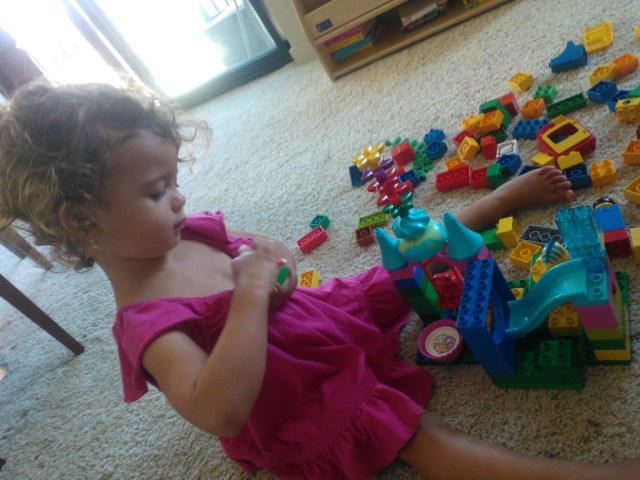My toddler got some pink and purple Lego Duplo blocks as a gift. Around that time, GoldiBlox came out with pink construction toys designed to interest girls in engineering. I thought it was all a bit silly, the idea that girls needed their own girly color of blocks to pique their interest in the toy. But it did give me pause. There is, of course, a gender gap in science, technology, engineering, and math-related careers–a divide caused by many factors. The pink blocks made me wonder:
What part do we parents play in that disparity between boys and girls?
Ability isn’t the issue. In one study of first-graders, boys started out better than girls at spatial tasks–the types of skills essential for architects and surgeons. But after eight weeks of practice, the gender gap was gone. Studies of adults show similar results.
Confidence plays a role. At one elite college, the females did better on a math test if they were subtly reminded of their intelligence just beforehand. They did worse on the math test if they were subtly reminded of their gender just beforehand. It’s called “stereotype threat.” (Think you’d never impose that kind of subconscious bias on your own child? Think again.)
These studies point to a few simple things we parents can do to help bridge the gap.
We can remind our children of their strengths before challenging tasks, thus turning stereotype threat to our advantage, the researchers say.
We can help our kids practice their spatial skills. Not an engineer, mathematician, or scientist yourself? Me neither. I’m reading Genius,” a biography of Nobel Prize-winning physicist Richard Feynman. When Feynman was a boy, his science-minded father would talk to him about worms, waves, and inertia in ways I’d never think to. I suppose we teach what we know. For the rest of us, Gwen Dewar at parentingscience.com has compiled a simple list of ways to improve kids’ spatial ability.
Her list includes using spatial language when we describe the world: big, little, thick, thin … circle, rectangle, triangle, octagon … curved, straight, edge, line. And asking questions like “Will the groceries fit in one bag?” Playing mental games that involve rotating shapes, like Tetris, helps, too.
We can also be enthusiastic participants when our kids build things.
stripslashes(strstr(" ", "class=") ? "" : "")
Those pink Legos got me thinking about the difference in my attitude toward blocks vs., say, books. I started wondering if my toddler loves reading so much in part because my husband and I are so enthusiastic about it (“Story time! Yay!”). We cuddle up with her and give our full attention; we make time for it every day; she sees us reading on our own.
We weren’t setting aside time each day to pull out the Legos. And because playing with blocks was something she could do on her own, I’d often see it as an opportunity for me to do something else.
When the pink and purple Lego blocks arrived at our house, our daughter had been happily playing for some months with the red, blue, yellow, and green versions she already had. She didn’t show any preference for the new colors. She was just glad to have more blocks, and so was I. So after giving it some thought, I’m making an effort to get down on the floor with her and build.
I want her to know that I value blocks, too–whatever their color.
Written by
Tracy Cutchlow
Tracy is the author of the international bestseller Zero to Five: 70 Essential Parenting Tips Based on Science, a public speaker, and a creator of places to speak and be heard. Sign up for her newsletter here.

I’m a nuclear engineer turned stay at home mom of two boys. I’ve obviously spent my engineering career thinking about and witnessing how being a female relates to that industry. I’ve kind of always prepared myself for how I would teach my daughters to know they can keep up intellectually. What I wasn’t prepared for was how much gender biasing I’ve witnessed – even from my own parenting generation – for the boys. I’ve heard everything from boys regress in potty training because they’re boys to oh you have a cut on your knee! You must be a boy! What is this telling our children? We tell them we are all equal when they are grown up – but when they’re toddlers it’s different? I just don’t see how we can expect things to change when we expose our kids to socially constructed biases from birth (or before).
Crystian, thank you for your thoughtful comment. It does seem difficult to change things when biases surround our kids from the start. I see shifts like this as generational. We’ll do a bit better than our parents’ generation, and our kids will do a bit better with their kids than we can, and so on. I would love to know some of the ways you imagined you would teach daughters to know they can keep up intellectually — and the things you now say to your boys after comments of “You must be a boy!”
So I’ve now added a beautiful baby girl to our clan. She’s only two months old. I had it in my head that I wouldn’t put her in anything pink, but we got so much pink stuff and I felt bad returning all of it I allowed us to keep one pink item from each gifter. It added up. I did ask my family buy some pink and purple for my sons and my aunt was the only one who did. I was going on allowing my girl to wear whatever I pulled out (now lots of pink) and one day I went to put my 21 month old sons only pink shirt on him which he had worn before a time or two. He refused. He told me it was the baby’s shirt. We think they’re too young to notice this stuff. The messages we send. They aren’t. My aunt bought the boys some more pink and I’ve stopped putting my daughter in as much. It just blew my mind he noticed that.